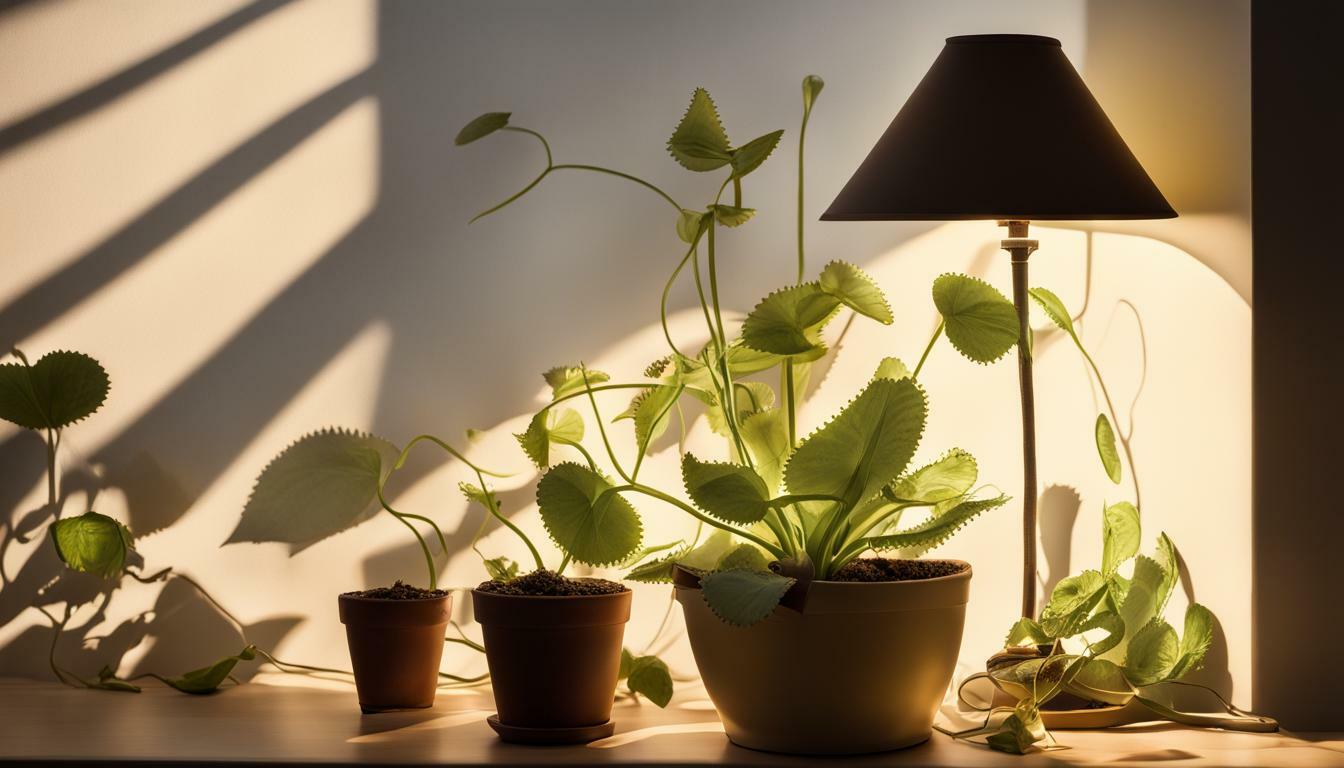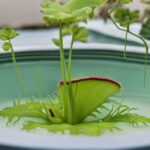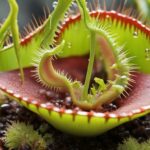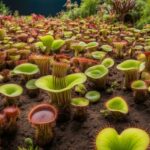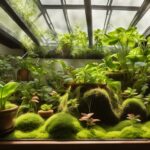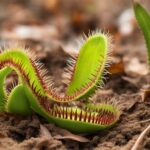Venus Flytraps are fascinating carnivorous plants known for their unique ability to capture and digest insects. However, like all plants, they require adequate light to survive and thrive. If you’re considering growing a Venus Flytrap, one key question you might have is whether they can survive in low light conditions.
In this section, we will explore the light requirements of Venus Flytraps and discuss whether they can adapt to low light environments. By understanding their needs and limitations, you can provide the best care for your Venus Flytrap and ensure its long-term health.
Key Takeaways:
- Venus Flytraps require adequate light to survive and thrive.
- Low light conditions can be challenging for Venus Flytraps, but they can adapt to some extent.
- Understanding their light requirements is crucial for caring for Venus Flytraps in any environment.
Understanding Venus Flytrap Light Requirements
If you’re considering keeping Venus Flytraps as houseplants, it’s essential to understand their specific light requirements. Venus Flytraps are native to wetlands with plenty of sun exposure, and as such, they thrive in bright, direct light conditions.
However, direct sunlight isn’t always necessary for Venus Flytraps to grow, and they can survive in partially shaded areas or in artificial lighting. As a rule of thumb, Venus Flytraps need at least 4-6 hours of direct sunlight or 12-16 hours of artificial light per day for optimal growth.
It’s important to note that the type of light source also affects Venus Flytraps’ well-being. They prefer full spectrum lighting, which mimics natural sunlight, and should avoid low-quality or dim light sources. If you’re growing Venus Flytraps indoors, consider using a grow light to supplement natural light or as the sole light source.
How much light do Venus Flytraps need?
Venus Flytraps require a minimum of 4-6 hours of direct sunlight per day to thrive. However, they can adapt to different lighting conditions and survive in partially shaded areas or artificial lighting. If you’re growing Venus Flytraps indoors, ensure that they receive at least 12-16 hours of artificial light per day.
Venus Flytrap Lighting Guide
For optimal growth and health, it’s crucial to provide Venus Flytraps with adequate light. Here are some tips for growing Venus Flytraps in different lighting conditions:
- Direct sunlight: Venus Flytraps love full, direct sunlight. If you’re growing them outdoors, place them in a sunny location, such as a south-facing window or a spot in your garden where they receive at least 4-6 hours of sunlight per day.
- Partial shade: Venus Flytraps can also grow in partially shaded areas. If they’re not receiving enough sunlight, they may become stressed and produce smaller traps. You can supplement natural light with artificial light sources, such as a grow light.
- Artificial lighting: Venus Flytraps can survive in artificial light as long as they receive a minimum of 12-16 hours per day. Use full spectrum lighting to mimic natural sunlight, and avoid low-quality or dim light sources.
By providing Venus Flytraps with adequate light and following their specific lighting requirements, you can ensure that they grow healthy, vibrant, and fully functional traps.
Low Light Conditions for Venus Flytraps
Venus Flytraps are notorious for their love of bright sunlight, but what if you want to grow them in low light conditions? While it may seem challenging, it is possible to cultivate these carnivorous plants in less than ideal lighting. However, you need to be mindful of their unique light requirements and make some adjustments to ensure their survival.
One way to grow Venus Flytraps in low light conditions is to provide supplementary lighting. LED grow lights are a popular option and can be easily set up to provide the right amount and type of light. Alternatively, you can place your plants under fluorescent lights, which are cheaper but tend to produce weaker light.
Another consideration for growing Venus Flytraps in low light is their container. Choose a pot with a lighter-colored surface to reflect more light back onto the plant. Additionally, make sure the pot has proper drainage to prevent waterlogging, which can cause root rot and damage the plant.
| Low Light Conditions Do’s | Low Light Conditions Don’ts |
|---|---|
|
|
It’s also essential to avoid exposing Venus Flytraps to too much heat or cold, which can stress the plant and cause damage. Keep the temperature in a range of 60-85°F (15-29°C) and avoid extremes on either end.
Finally, make sure to adjust your care routine to reflect the lower light conditions. Venus Flytraps may not require as much water or fertilizer in low light, so be mindful of their needs and adjust accordingly. With proper care and attention, you can successfully grow Venus Flytraps in low light conditions and enjoy these fascinating plants.
Venus Flytrap Adaptations to Low Light Conditions
Venus Flytraps are remarkable carnivorous plants that can adapt to low light environments. However, their unique adaptations are critical for their survival and growth. Here are some of the ways Venus Flytraps have adapted to low light conditions:
- Smaller Size: Venus Flytraps grown in low light typically have smaller traps and leaves compared to those grown in brighter light. This adaptation allows the plant to conserve energy and nutrients that are otherwise used for growth.
- Longer Leaf Stalks: In low light conditions, Venus Flytraps develop longer leaf stalks to elevate their traps above surrounding plant foliage and capture more light. This adaptation helps to increase the photosynthetic surface area of the plant.
- Increased Chlorophyll: Venus Flytraps grown in low light conditions produce more chlorophyll, which is the pigment responsible for photosynthesis. This adaptation enables the plant to absorb more light and nutrients in low light environments.
- Slower Metabolism: In low light conditions, Venus Flytraps have a slower metabolism, enabling them to conserve energy and grow at a slower pace. This adaptation is necessary because the plant cannot obtain enough energy through photosynthesis alone.
While these adaptations allow Venus Flytraps to survive in low light, it’s crucial to provide them with enough light to promote healthy growth and prevent stress. Additionally, providing a low light environment that mimics their natural growing conditions helps ensure their long-term health.
Tip: If you’re growing Venus Flytraps in low light, ensure they receive at least 12 hours of bright, indirect light each day. You can achieve this by placing them near a north or east-facing window or supplementing their light with grow lights.
By understanding the unique adaptations of Venus Flytraps in low light conditions, you can better care for these fascinating carnivorous plants and create an environment where they can thrive.
Tips for Caring for Venus Flytraps in Low Light
If you want to grow Venus Flytraps in low light conditions, it’s essential to know how to take proper care of them. Here are some tips to help you keep your Venus Flytraps healthy:
- Light Preferences: While Venus Flytraps can survive in low light, they still require some amount of light to photosynthesize. Provide them with at least four to six hours of bright, filtered light per day. South-facing windowsills are an excellent option to provide adequate light.
- Watering: Venus Flytraps need moist soil to survive, but they can’t tolerate standing water. Water them regularly, but make sure the soil is never too wet. Use distilled or rainwater to avoid mineral buildup.
- Fertilizing: Venus Flytraps don’t need fertilizer, but they can benefit from occasional feeding. Use a low-nitrogen fertilizer specifically designed for carnivorous plants, and follow the instructions carefully.
- Potting: Use a well-draining mix of peat moss and perlite to pot your Venus Flytrap. Avoid using regular potting soil as it can retain too much moisture and cause root rot.
- Humidity: Venus Flytraps thrive in high humidity. Use a humidity tray or mist the plant regularly to keep the air moist.
By following these care tips, you can successfully grow Venus Flytraps in low light conditions. Remember to monitor your plant’s health and adjust care as needed to ensure its longevity.
Conclusion
In conclusion, Venus Flytraps can indeed survive in low light conditions. However, it is essential to understand their specific light requirements and make necessary adjustments to ensure their well-being.
It is crucial to provide adequate lighting to your Venus Flytrap for the plant’s long-term health and growth. While they are adaptable, you need to carefully consider the amount of light they receive, as providing too little can lead to stunted growth, weakened plants, and even death.
Tips for Success
When caring for Venus Flytraps in low light conditions, it is recommended to keep them near a bright window or under artificial lighting to supplement the lack of natural sunlight. Be sure to avoid placing them in direct sunlight, as this can quickly overheat and damage the plant.
Additionally, you should maintain consistent watering and fertilizing practices to ensure your Venus Flytrap remains healthy and strong. Remember to use distilled water and avoid tap water, which can contain minerals harmful to the plant. You can also use a diluted, low-nitrogen fertilizer to supplement the nutrients available in the soil.
By following these tips and providing your Venus Flytrap with proper care and attention, you can successfully cultivate these fascinating carnivorous plants even in low light environments.
What Temperature Range Is Ideal for Venus Flytraps to Thrive in?
The best temperature conditions for venus flytraps to thrive in range from 70 to 85 degrees Fahrenheit. These carnivorous plants prefer warm and humid climates, which imitate their natural habitat. Keeping them within this temperature range ensures optimal growth and allows them to capture insects using their unique trapping mechanism.
FAQ
Q: Can Venus Flytraps survive in low light conditions?
A: Yes, Venus Flytraps can survive in low light conditions, but it is not ideal for their long-term health and growth. They require a certain amount of light to thrive.
Q: What are the light requirements for Venus Flytraps?
A: Venus Flytraps require bright, direct sunlight for at least 6 hours a day. They need full sun exposure to perform photosynthesis and catch prey.
Q: How can I grow Venus Flytraps in low light conditions?
A: If you want to grow Venus Flytraps in low light conditions, you can use artificial grow lights specifically designed for plants. These lights should provide the necessary spectrum and intensity of light.
Q: What adaptations do Venus Flytraps have for low light conditions?
A: Venus Flytraps have developed adaptations to survive in low light conditions. They have elongated petioles to reach for light, and their traps have evolved to be more sensitive to prey, compensating for diminished light levels.
Q: How do I care for Venus Flytraps in low light conditions?
A: When caring for Venus Flytraps in low light conditions, it is important to monitor their watering and avoid overwatering. Additionally, you can supplement with organic fertilizer to provide essential nutrients.

